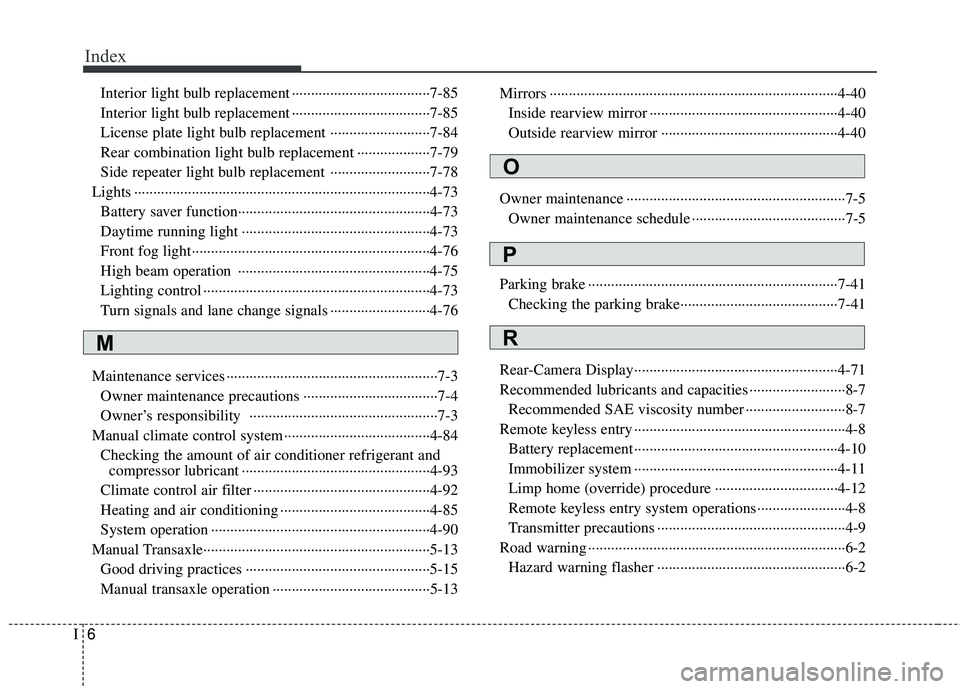Page 289 of 449

Driving your vehicle
42
5
ISG system deactivation
If you want to deactivate the ISG sys-
tem, press the ISG OFF button. The
light on the ISG OFF button will illumi-
nate and the notice will illuminate on
the LCD display (for type B cluster).
If you press the ISG OFF button again, the system will be activated and the
light on the ISG OFF button will turn
off.
ISG system malfunction
The system may not operate when:
- The ISG related sensors or systemerror occurs.
The yellow AUTO STOP indicator ( )
on the instrument cluster will stay on
after blinking for 5 seconds and the light
on the ISG OFF button will illuminate. If
your vehicle is equipped with cluster type
B cluster, the notice will illuminate on the
LCD display. If the ISG OFF button light is not turned off
by pressing the ISG OFF button again or
if the ISG system continuously does not
work correctly, please contact an author-
ized Kia dealer as soon as possible.
✽ ✽
NOTICE
If the AGM battery is reconnected or
replaced, ISG function will not operate
immediately.
If you want to use the ISG function, the
battery sensor needs to be calibrated for
approximately 4 hours with the ignition
off and then, turn the engine on and off
2 or 3 times.OUB051023
■ Type A■Type B
■Type BOUB051006/OUB051059
WARNING - Engine Repair
Turn the ignition switch to the
LOCK (OFF) position or remove the
key from the ignition completely
before performing work on the
vehicle in the engine area. Failure
to do so could result in serious
injuries due to sudden engine reac-
tivation.
OUB051011
Type : B
Page 298 of 449

551
Driving your vehicle
Use high quality ethylene glycol
coolant
Your vehicle is delivered with high quality
ethylene glycol coolant in the cooling
system. It is the only type of coolant that
should be used because it helps prevent
corrosion in the cooling system, lubri-
cates the water pump and prevents
freezing. Be sure to replace or replenish
your coolant in accordance with the
maintenance schedule in section 7.
Before winter, have your coolant tested to
assure that its freezing point is sufficient
for the temperatures anticipated during
the winter.
Check battery and cables
Winter puts additional burdens on the
battery system. Visually inspect the bat-
tery and cables as described in section
7. The level of charge in your battery can
be checked by an authorized Kia dealer
or a service station.
Change to "winter weight" oil if
necessary
In some climates it is recommended that
a lower viscosity "winter weight" oil be
used during cold weather. See section 8
for recommendations. If you aren't sure
what weight oil you should use, consult
an authorized Kia dealer.
Check spark plugs and ignition
system
Inspect your spark plugs as described in
section 7 and replace them if necessary.
Also check all ignition wiring and compo-
nents to be sure they are not cracked,
worn or damaged in any way.
To keep locks from freezing
To keep the locks from freezing, squirt an
approved de-icer fluid or glycerine into
the key opening. If a lock is covered with
ice, squirt it with an approved de-icing
fluid to remove the ice. If the lock is
frozen internally, you may be able to thaw
it out by using a heated key. Handle the
heated key with care to avoid injury.
Use approved window washer
anti-freeze in system
To keep the water in the window washer
system from freezing, add an approved
window washer anti-freeze solution in
accordance with instructions on the con-
tainer. Window washer anti-freeze is
available from an authorized Kia dealer
and most auto parts outlets. Do not use
engine coolant or other types of anti-
freeze as these may damage the paint
finish.
Page 446 of 449

Index
6I
Interior light bulb replacement ··················\
··················\
7-85
Interior light bulb replacement ··················\
··················\
7-85
License plate light bulb replacement ··················\
········7-84
Rear combination light bulb replacement ··················\
·7-79
Side repeater light bulb replacement ··················\
········7-78
Lights ··················\
··················\
··················\
··················\
·····4-73 Battery saver function··················\
··················\
··············4-73
Daytime running light ··················\
··················\
·············4-73
Front fog light··················\
··················\
··················\
········4-76
High beam operation ··················\
··················\
··············4-75
Lighting control ··················\
··················\
··················\
·····4-73
Turn signals and lane change signals ··················\
········4-76
Maintenance services ··················\
··················\
··················\
·7-3 Owner maintenance precautions ··················\
·················7-4
Owner’s responsibility ··················\
··················\
·············7-3
Manual climate control system··················\
··················\
··4-84 Checking the amount of air conditioner refrigerant andcompressor lubricant ··················\
··················\
·············4-93
Climate control air filter ··················\
··················\
··········4-92
Heating and air conditioning ··················\
··················\
···4-85
System operation ··················\
··················\
··················\
···4-90
Manual Transaxle··················\
··················\
··················\
·····5-13 Good driving practices ··················\
··················\
············5-15
Manual transaxle operation ··················\
··················\
·····5-13 Mirrors ··················\
··················\
··················\
··················\
···4-40
Inside rearview mirror ··················\
··················\
·············4-40
Outside rearview mirror ··················\
··················\
··········4-40
Owner maintenance ··················\
··················\
··················\
···7-5 Owner maintenance schedule ··················\
··················\
····7-5
Parking brake ··················\
··················\
··················\
···········7-41 Checking the parking brake··················\
··················\
·····7-41
Rear-Camera Display··················\
··················\
·················4-71\
Recommended lubricants and capacities ··················\
·······8-7 Recommended SAE viscosity number ··················\
········8-7
Remote keyless entry ··················\
··················\
··················\
·4-8 Battery replacement ··················\
··················\
·················4-10\
Immobilizer system ··················\
··················\
·················4-11\
Limp home (override) procedure ··················\
··············4-12
Remote keyless entry system operations··················\
·····4-8
Transmitter precautions ··················\
··················\
·············4-9
Road warning ··················\
··················\
··················\
·············6-2 Hazard warning flasher ··················\
··················\
·············6-2
M
O
P
R